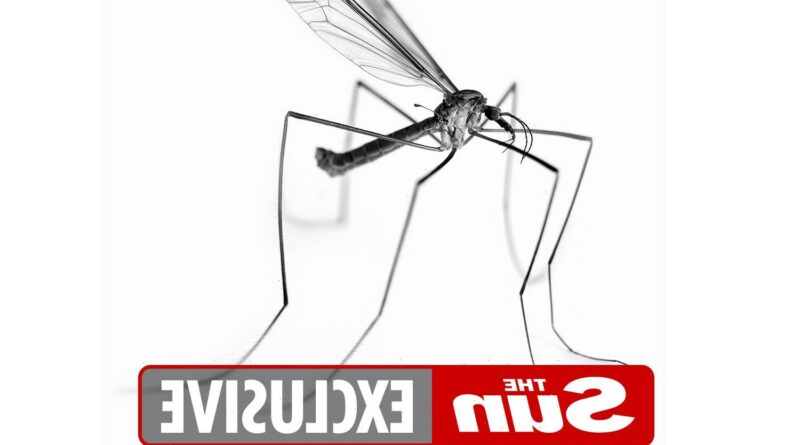Why swarms of Daddy Long Legs are set to plague Britain after damp summer
THE wet weather has put a dampener on summer this year but it’s also brought fresh misery for bug-hating Brits – a plague of Daddy Long Legs.
This week experts warned that millions of the spindly-legged critters, otherwise known as crane flies, were set to be unleashed on the nation.
The cool damp spring has left soil conditions perfect for the larvae – known as leatherjackets – to hatch into adult flies before swarming out of their burrows to breed as the autumn sets in.
Though harmless, the two inch bugs – which live between two days and two weeks – invade homes in their short-lived search for a mate.
“I have already noticed more crane flies buzzing around than usual,” says entomologist Christopher Terrell-Neild of Nottingham-Trent University.
“The eggs develop slowly as larvae over the winter and, normally a lot of them die. But if the winter is not too cold and the spring is damp as well it’s quite likely that more will emerge.”
Christopher explains that the adult fly emerges from the ground between late August and early October, depending on the weather.
But while the adults are harmless, the larvae are much more of a nuisance – particularly if you have a lawn.
Most read in News
RUNNING WILD Inside 'Little Beirut' estate where locals build FORTS to save homes from yobs
Mum DEFENDS thug son who left girlfriend Angel disabled in shock statement
'Scruffy' Andrew told cop to 'f*** off' after HE sparked security scare
Chilling moment rapist carries woman along the streets before attack
Each fly will lay around 300 eggs which hatch into larvae in around two weeks.
“Leatherjackets live in turf and lawns and eat the roots of the grasses and you can get a dozen or so per square metre," he says.
"If you multiply that up with the area of grasslands in the country, that’s a very large number of Daddy Long Legs."
How to keep Daddy Long Legs out of your home
They may be harmless, but they can be annoying…
- Trim any plants that are close to your home and clean away any leaves, wood, rubbish or debris that might attract them and offer them a hiding place
- Mow the lawn – the longer your grass, the more attractive it is to flies looking to nest
- Repair and seal any cracks and crevices in the walls, doors or windows of your home, or try putting weather strips around the edges
- Keep up with your housework and hoover any dark corners or crevices that they may choose to hide in
- It's best not to kill these critters, but if you're really desperate, apply some bug spray around the entrances and windows of your home.
Like many insects, Daddy Long Legs are attracted to light – and with nights drawing in Brits risk a home invasion.
“Autumn means people have lights on and because it’s been quite mild, they are leaving the windows open,” he says.
“The ones I saw this weekend were flying around a pub, but they don't come in for food because adults don't feed the adults. They’re just looking for mates.”
Fluttering in face and shedding legs
One reason Brits hate them, says Christopher, is their tendency to lose legs.
“The problem is that they flutter around, often in your face, and they've got the long legs," he says. “They also have what we call deciduous legs, which means they fall off easily if you touch them, and people don’t like that very much.”
While many are freaked out by the gangly insects, Dr Erica McAlister, the Natural History Museum’s resident fly expert, says we should be pleased to see them.
“They have a very short lifespan and they only have one thing on their mind – breeding,” she says.
“They rarely feed as adults. They will take some nectar and water but that is it so they won’t spoil your food.
“They have a really bad reputation for what they are. They are totally harmless. The worst they could do is dangle their legs in your face.
“We have got some beautiful species in the UK and a lot of them are indicators of ancient woodlands and things like that, habitats like that.
"Not only are they not not going to kill us, but they're also really helpful, really beneficial.”
There’s also hope for lawn lovers who want to rescue the grass from the munching monsters below.
Christopher recommends using nematode worms – tiny worms you can buy at the garden centre which you then water into the lawn, where they dig themselves into the leatherjacket bodies and kill them off.
Next spider invasion underway
More worryingly for arachnophobes, this time of year is also mating season for spiders.
"The next spider invasion is already underway," he says. "It's mating season so expect to see spiders trawling across the hearth rug at night because the males will be hunting for females to mate with them.
"This time of year, with people inside more and windows open, there will be many species coming in. It's the living world striking back."
Source: Read Full Article











